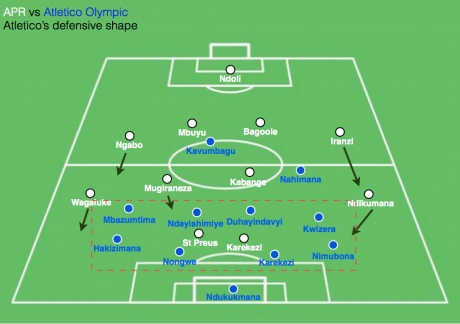Another rigid defensive display from Burundi’s Atletico Olympic saw them hold Rwandan Primus League champions, APR, to a 0-0 draw at the 2012 CECAFA Kagame Cup, in Dar es Salaam on Tuesday.
As expected, Atletico Olympic’s coach, Cedric Kaze, named an unchanged line-up following his side’s impressive 2-0 win over Yanga on Saturday. Nahimana kept his place alongside two goal hero, Didier Kavumbagu, with defensive minded duo, Duhayindavyi and Ndayishimiye anchoring the centre of the Burundian’s midfield.
APR’s Dutch coach, Ernie Brandts, opted for a 4-4-2 formation, with Rwandan internationals Jean-Claude Iranzi, Olivier Karekezi, Jean-Claude Ndoli and Jean-Baptiste Mugiraneza in the starting eleven. Selemani Ndikumana and Ugandan winger Dan Wagaluka were set to provide the side with advanced attacking options, in wide areas.
Atletico’s speed of recovery in the transition
APR dominated the early exchanges. The physicality and aggressiveness of Mugiraneza and Kabange in the centre of midfield gave the Rwandan’s an edge over the Burundian champions. But, despite having the ability to retain possession inside the midfield third, the narrow positioning of Atletico Olympic’s midfield four, particularly the close positioning of central midfield duo, Duhayindavyi and Ndayishimiye, meant that APR struggled to deliver penetrating forward passes into areas beyond Atletico Olympic’s midfield line.
It was not just this defensive positioning that enabled Atletico to restrict APR’s creative play, but the speed at which they were able to regain their defensive shape, in the turnover, made it even more difficult for the Rwandan’s to hurt their opponents on the counter.
(See diagram 1 showing Atletico Olympic’s defensive positioning)
Atletico also impressed with the speed of their counter attacks. The combination of Nahimana and Kavumbagu up front gave the Burundian’s two natural target men; both adapt at playing front and back to goal. In the turnover, central midfielder Ndayishimiye made several driving forward runs in support of his two strikers. The teams’ wingers, Kwizera and Mbazumutima, were also quick to take up narrow positions in support of the front two. With half an hour gone, and despite having enjoyed considerably less possession than their Rwandan counterparts, Atletico had had more shots on goal (5), compared with APR’s (1).
The importance of varied attacking options and tempo, in the attacking third
Despite dominating possession in the first half (61% to 39%) APR had only one attempt on goal. With Atletico’s midfield and defensive lines closely positioned, the Rwandan’s were in need of more varied attacking options and a higher tempo, in possession, to stretch and pull their opponents out of position.
Interestingly, rather than drawing Atletico out, by maintaining possession in deeper areas, or encouraging more sustained pressure from their opponents, APR attempted to force the Atletico defensive lines deeper, trying to open up space inside their half.
In the opening stages of the second half the focus of their attacks was down the flanks. In the transition, Kabange dropped deep to receive the ball from his back four before playing quick passes into wide areas, allowing Dan Wagaluka and Jean-Claude Iranzi to deliver crosses into the box from deeper positions. The key to this was the speed at which Kabange could deliver accurate passes to the wide areas, and the quality of Wagaluka and Iranzi crosses into the box.
The objective of this tactic was to force Atletico’s defensive line to step back into deeper areas; where, even if they were successful in clearing their lines, they would be likely to surrender space to APR’s attackers, 25-30 yards from goal. And with crosses now deliverable from deeper areas, it would force the Atletico’s wingers to press higher and wider; conceding more space in central areas, outside of the penalty area.
APR’s coach, Ernie Brandts, drew back Oliver Karekezi from the front two, playing him off St Preus, in a 4-4-1-1. This gave Karekezi more opportunities to play front to goal, feeding off knock down headers from St Preus.
(See the diagram below showing APR’s positioning in the attacking third, with the early crosses from wide areas)
However, the positioning and awareness of the Atletico centre backs, Karekezi and Nongwe, was a major factor in keeping the APR attacking unit at bay, denying them clear goalscoring opportunities from crosses into the box. Considering ARP’s clear height advantage, this is an area of their performance that coach Ernie Brandts must be disappointed with.
Much like Yanga before them, APR will have expected to take all three points against their less illustrious Burundian opponents. But yet another stern defensive performance from Atletico means they are now well deserved favorites to top Group A and qualify for the quarter finals.

